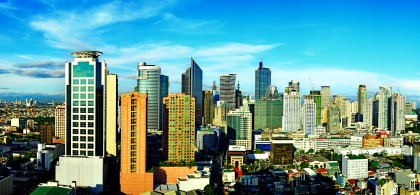Philippine Economy Latest News ; Among Asia’s Top Performers Amid Challenges
The Philippines remained one of the best performers among Asian economies this year despite typhoon damage and falling public spending, even as the country continued to face challenges in achieving job-rich and inclusive growth.
The country’s gross domestic product (GDP) grew by 5.8 percent in the first three quarters of 2014, slightly below the government’s 6.5 percent target for the year.
The Philippines was the fourth best performer in terms of growth in the third quarter, behind China, Vietnam and Malaysia.
Socioeconomic Planning Secretary Arsenio Balisacan said economic growth was expected to be higher in the fourth quarter amid a rosier outlook of businesses and consumers on the back of strong macroeconomic fundamentals.
Balisacan added that the industry and services sectors continue to drive growth this year.
He said the recent powerful typhoon "Ruby" had “very negligible” impact on the economy, estimating that the weather disturbance could translate to a potential loss of only 0.03 percent of GDP in the fourth quarter. The share of agriculture in GDP is just about 11 percent.
Balisacan, who is also the National Economic and Development Authority (NEDA) Director-General, believed that the lower oil prices would be favorable to the economy, as these would further reduce inflation rate and increase the purchasing power of Filipino consumers.

Makati, Manila, Philippines
But despite robust economic growth, the NEDA chief said the country still needs to do more to substantially reduce poverty and ensure inclusivity amid climate-related disasters, along with the uncertainties in the global economy. “
We can say that the Philippine government has remained resolute in its stance to strengthen the foundations for sustained and inclusive growth through wide-ranging reforms in governance and the economy,” Balisacan said.
He said the government will continue to implement measures to enhance revenue generation, regulatory efficiency, improve the links between planning, investment programming and budgeting, and build capabilities on planning, budgeting and budget execution.
Citing a business expectations survey, Balisacan said the continued business confidence has translated into higher investments and investment commitments.
NEDA said increasing investments from employers to generate high-quality and remunerative employment is crucial in achieving poverty reduction towards inclusive growth.
Latest labor force survey indicated the country’s unemployment rate declined to a 10-year record low of 6.0 percent.
Balisacan outlined the strategies to further accelerate job creation, including continuous build-up of capital, promotion of priority sectors, stable macroeconomic fundamentals, investment in research and development in the agriculture, industry and services sectors, and reducing the cost of doing business.
“…The Philippine economy should consistently grow at a rapid pace over a longer period of time in order to effectively solve the poverty problem,” he added.
2015 Outlook
The Philippines' hosting of the Asia-Pacific Economic Cooperation (APEC) Summit and higher infrastructure spending are crucial for achieving a seven to eight-percent economic growth target in 2015.
“We are maintaining the seven to eight-percent growth rate because there are events happening next year. We are hosting the APEC Summit and that will be a big boost tourism-wise,” said NEDA Assistant Director General Rosemarie Edillon.
The first leg of the APEC Summit has started and a series of meetings leading up to the Economic Leaders’ Meeting in November 2015 will happen throughout the year.
Apart from hosting the APEC Summit, the NEDA is banking on higher infrastructure spending, super typhoon "Yolanda" recovery and reconstruction, and the ASEAN economic integration boosting next year’s economic growth.
“We will also take advantage of the opportunities presented by the country’s hosting of APEC meeting and the implementation of the ASEAN Economic Community by the end of 2015,” Balisacan said.
He said tourism will pick up next year due to the hosting of APEC Summit and favorable sentiment towards the country.
“The resurgence of industry sector, particularly manufacturing, construction, logistics and investments both public and private, are expected to remain robust,” he added.
Further, Balisacan noted that government spending could be a major contributor to growth next year.
The government targets to roll out nine more public-private partnership (PPP) projects with combined cost of PhP702.78 billion in 2015.
These projects include the PhP374.5-billion Makati-Pasay-Taguig Mass Transit System Loop, PhP177.21-billion North-South Rail Project (South Line), and PhP50.18-billion Regional Prison Facilities through PPP Project.
The PPP Center is currently bidding out 12 projects and the biggest among these is the PhP122-billion Laguna Lakeshore Expressway Dike Project.
It has so far awarded the PhP64.9-billion Light Rail Transit (LRT) Line 1 extension to Cavite and seven other projects.
“When it (election spending) comes, it could be another bonus. In the next 10 to 20 years, our economy should be joining its peers in the more vibrant ASEAN region,” Balisacan further said.
“The reforms we are pursuing are necessary to enable us to join our peers in those high growth economies. With ASEAN (economic) integration or not, we should be accelerating our reforms,” the NEDA chief added. (PNA) SCS/Leslie D. Venzon/ebp


